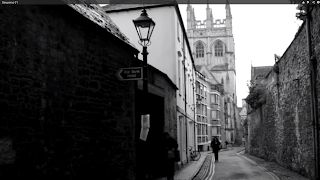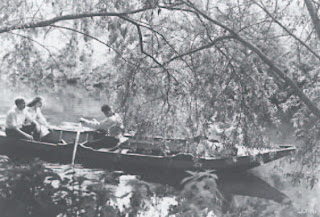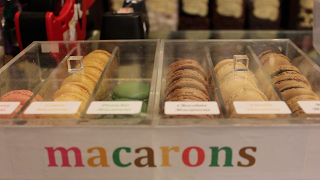Edited version of some footage
I have selected a handful of the footage we have shot over the last couple of months in order to evaluate the experience, techniques and learning curve that has been achieved. Although it is only a small amount of what we shot, I have chosen much my personal favourite and also the footage that I feel reflects the New Wave techniques as close as possible. Additional, I have tried to include as many techniques as I could in order to present the range of techniques learnt.
A further edit of extra footage can be found in the 'Editing' Page on this blog. Please select link to be taken to it.
Evaluation
In this edited sequence above, within the first few seconds I have adopted a technique that the new wave film makers are known for, and that is the jump cut. The jump cut was used often in the new wave films and was very unusual as smooth editing and continuity are so so important for the film that come out of Hollywood. The surroundings of the location were shot in the local park, this is the same shoot in which we made good use of the reflector (please click link see to see related blog post). These are also techniques that take into account conventions of french new wave movement. firstly, using a local park as a location for filming adds an element of realism that is vital when considering the nouvelle vague stylistics. The reflector optimises the natural lgihting that we had to work with while maintaining the low budget, this something that the new wave directors had to continuously consider as often extra lighting was not something they had money for. The subject within the footage is a non-professional actor, this again was common in the new wave films, adding further realism to the film and again keeping to a lower budget.
At around 0.47 you can see how the footage was shot with a hand-held camera due to the very unsteady finish, hand-held camera was often used in the new wave films, giving them an air of realism. Moving forward a couple of seconds we are taken into a close up shot of the subjects hand scratching a stone on the floor. By experimenting with cut away shots, we were able to gain a good idea of just how many different shots you should get of the same scene in order to give you plenty to work with when editing. For this particular footage we took around 7-10 shots from different angles and different distances. This was the same for the footage of the subject standing centre frame at the start of the short film.
You can see throughout this section of footage (40-50 secs aprox.) the shallow depth of field we shot in, this is due to the wide aperture. These camera setting worked well in combination with the natural light and reflector, giving the footage a nice sharp finish and focussing on a particular point within the frame.
At 1.21 we cut to a shot of the a new subject stood on a merry-go-round, this was one of our more effective experimentations with camera movement, by placing the camera and tripod onto the merry-go-round platform, we achieved a smooth a tracking shot following the subject as it spun. This combined with a relatively slow shutter speed kept the foreground subject in focus while the background blurred out of focus. As you can see, this particular shot is not as wide as the ret resulting in a black border around the image, this was a problem that we came across during editing. We had not realised at the time of filming that the camera settings had been different on this particular occasion, therefore only realised when the footage was uploaded. I choose to leave it this way and not try to alter the difference as this lack of continuity was often a feature of the nouvelle vague, film makers of the movement did not always have the money to reshoot and therefore had to deal with any problems and work with them the best they could. Again I used jump cuts, a major feature of the nouvelle vague as this broke up the otherwise very long take. I opted to keep the shot running for as long as it does as this is something the new wave film directors often did, so I tied out there technique. With regards to the choice of music, the length of this shot works fairly well especially in contrast to the jump cuts throughout the beginning of this piece.
As we move to a further shot, we can see see more jump shots as a gondola moves down a river. This change of scene is the beginning of the footage taken in Oxford, demonstrating a contrast between the grittier, earlier location and the new one. This shot actually has slight resemblance to a scene from Truffaut's Jules et Jim ( 1962). as you can seen from the screen shot below.
I, again, incorporated the jump cuts to break down the length the of the take. We then move to busier high street in which we can see people walking past, the fact these subjects are unaware that they are being filmed gives us a chance to gain an element of realism within our footage. The most obvious are the woman walking towards the camera lighting a cigarette and in the background of the shot you can see a man riding a bike waving as he passes by. Something that liked about this particular piece of footage was how the female subject remained ever so slightly out of focus while the background (buildings and street behind her) were crisp and in focus. This again adds some element of realism, I feel as it suggests that in everyday life we do not notice every single person we may cross paths with. This realist feel relates back to the the brief.
Obviously, it is clear to see that we have not stuck to brief exactly, the original brief said we would be filming conversations between people about contemporary issues and although we have not directly done this, as a group we had been researching other new wave movements. In my case, I was looking at the czechoslovak, for this reason, in the editing process we added elements of our own researched movement t incorporated and adapt the techniques of the french new wave but still remaining true to their most notable conventions. Through our footage we have also been able to explore contemporary social issues without having the blatantly discussed in front of the camera, this in my opinion is more closely resemblant of the new wave than the idea stated in the original brief.
All of the footage in this edit has been changed into a high contrast mono-chrome to reflected a large amount of the new wave films, I come back again to Godard's Breathless and Truffaut's 400 Blows. Although reality is of course not seen in black and white, it has come to be a format which is related to realism. This is due to the fact the in the late 1920's to early 30's when technicolor was becoming more popular, it was often used in musicals or Classic Disney features, hence, it became related to fantasy.
At around 3mins 53secs in the sequence, we come to shot from within the Oxford Sweet shop, here you can see how the foreground begins out of focus and slowly the focus shifts as the background becomes more blurred. When filming this piece we opted to experiment with focus shifts to see what effect it would have on the footage. This shot as well as the following one allowed us to experiment a little more with close ups and shot composition as there is lots of lines and angles with these frames.
One of the shots that follow a little further on (at around 5.03) is one of my favourites. This is due to the natural lighting, particularly when in mono-chrome and the composition of the image within the frame. I feel that the viewers attention is drawn towards the end of the road and to the top of the cathedral seen in the background. During the shot we also have many subjects passing by the camera, one of which looks towards the camera, this breaks the barrier between film and viewer adding the realist style of the new wave that we were aiming to achieve.
Overall, although we clearly did not maintain a link with the brief with regards to the narrative of the final edited sequence, the footage we got stays in line with the themes and conventions that were outlined. The whole process we carried out with a low budget which caused us to have to think more like a new wave director as we had to over come obstacles by thinking creatively. I.e. how we could make use of footage that had not turned out exactly the way we hoped and how to gain different vantage points etc which only what we had around us. One big learning curve that personally I took from the whole experience was how much had to be throughout about before shooting anything. I feel that health and safety considerations are much more at the fore front of my mind when thinking about filming, adapting these depending on what kind of location/situation filming is carried out in. Another point to mention would be how much more confident I feel about handling a camera, my knowledge of settings, composition and lighting has definitely improved and hopefully shows in later work.
Screen Shots from the editing process:

These three screen shots show the choosing of the footage for the sequence and also renaming the clips for when they are imported into the editing software, Adobe Premier Pro.
These three are the actual process of editing, putting the footage into an order adding effects and music to complete the sequence.





















